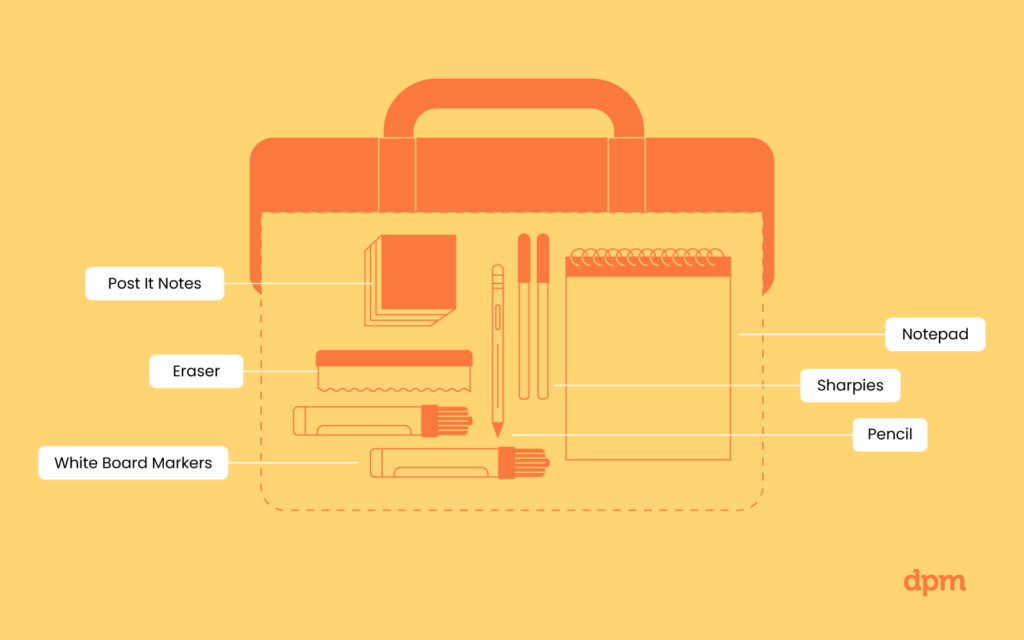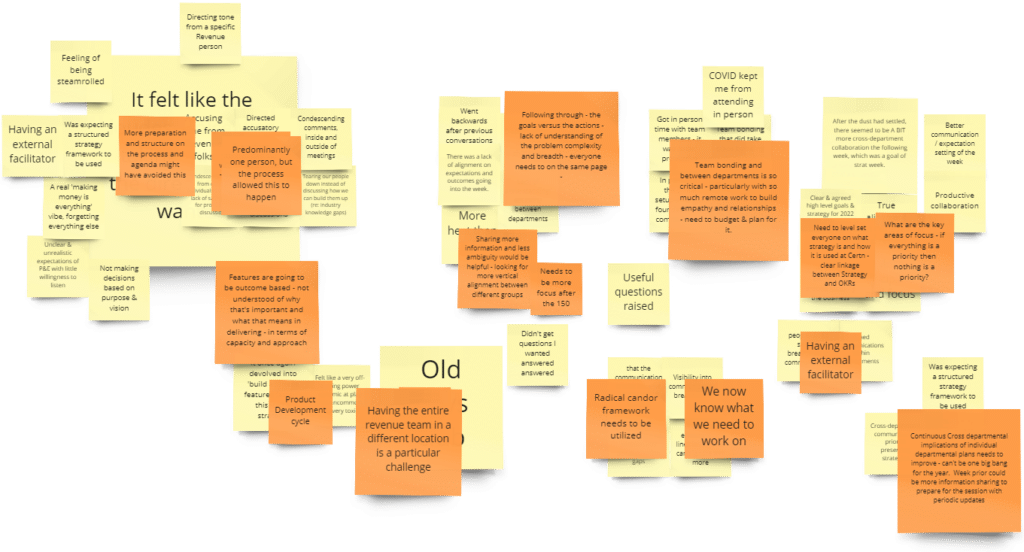Did you know that brainstorming or brainwriting has been around since 1953! It is credited to Alex Osborn and is a technique that I use regularly in projects and multiple business situations. If the number of online platforms that have added whiteboard functionality to their platforms in the last 6 months is any indication, brainstorming is a core function of meetings in the virtual world.
As project managers, one of our key roles or skills is as a facilitator—whether it's ideation to solve a problem, doing retrospectives, or gathering different perspectives, facilitating a brainstorming session is a basic skill for a project manager.
While it is a fundamental practice to solicit input from teams, this isn’t always done well. I’m going to explore how to do it more effectively in your team, and I’ll cover everything from how to get your team focused to brainstorming techniques that will get the best out of the group and produce real results.
As Alex Osborn said:
It is easier to tone down a wild idea than to think up a new one
Group brainstorming is all about finding those wild ideas and it helps us solicit creative ideas from people with:
- Specialized knowledge
- Diverse ways of thinking
- Diverse perspectives
I’m going to explore five best practices to harness group brainstorming and help your digital project in key areas of scope ideation, creative problem solving, and doing retrospectives.
I’m Annie MacLeod, a passionate and seasoned project manager and coach who thrives on building collaboration experiences for remote teams and their projects. These experiences cross the spectrum of project management from creating project plans and doing deep dive retrospectives to making decisions and improving team culture.
1. Building the best brainstorming process
It may sound counterintuitive, but to have an effective brainstorming session you need to spend some time planning it up front—the group setting, technology or tools, ground rules, and roles.
How To Implement
Some key decisions you’ll want to make before you schedule your session are:
- Who is the facilitator of the session? If the project manager wants to actively participate, then consider using a separator facilitator. Think about the project manager’s ability to do timekeeping, maintain neutrality and objectivity, and actively listen throughout the session. Check out some of these other ideas—having a facilitator can take a lot of pressure off a PM and allow them to participate and really listen deeply.
- How is the session going to be conducted? This is particularly important when it's being done in a distributed or hybrid environment. Depending on the audience, their tech savviness, and the tools you’re going to use to capture inputs, you may want to consider having material for participants to practice before jumping into brainstorming ideas.
- How will I set up an atmosphere of psychological safety? One quick tip is to set up ground rules for the session. Things like no bad ideas, don’t speak over top of others, one conversation at a time are known as ‘table stakes’. Explore other ideas with this link.
2. Start with the end in mind to frame the session
While brainstorming is an activity that can be done at the drop of a hat (I have a toolkit I lug around to every client meeting stuffed with post it notes and markers for just such an occasion), I find it most effective if it's an activity that contributes to the planned outcome of a meeting—which means it needs to be framed.
While we are trying to stimulate wild ideas, we are also trying to achieve an outcome and brainstorming is part of the method to get there, as it involves generating a good number of ideas and then refining them.

So what we need to do for an effective brainstorming session is invite the right people to attend and to lay out the context of the brainstorm.
That will ensure that while we gather the right quantity of ideas, everyone is on a level playing field in the context of the brainstorming session.
Here’s how that plays out for some of our key project meetings: scope ideation, problem solving, and retrospectives.
| Example Meeting | Invitees | Context |
|---|---|---|
| Scope Ideation | Ensure you get as close as possible to the people that will measure the success of this project. Also, ensure you have the people that will be planning the scope—those that understand how the problem can be solved. Make sure that you have attendees that can stand up for and express ideas for stakeholders that can’t be there, or have data or research to support what the problem is (particularly true for client/customer issues). | What is the problem we’re trying to solve?Who are we trying to solve it for?Why is this important?When and how does this problem occur? |
| Problem Solving | This is all about getting as many possible solutions on the table as you can and really using all the specialized knowledge you have in the room. You want people who have first hand knowledge of the problem—they have observed it or experienced it. Make sure those familiar with the environment that is being affected cover all the technical bits that go into the environment. Ask for input from people that can not only describe potential technical solutions but training, communication, and other aspects of the potential solution as well. | Where is it broken?What have we tried so far to resolve the problem?Who is it impacting? What is the size of the issue?What is not impacted? |
| Retrospective | Not just the people who are doing the work but the customers of the work as well. | What are we reflecting on? From when to when?Why are we doing this retrospective—to learn, to vent, to heal relationships? |
The second part of this is to structure the brainstorming session appropriately and use techniques that will resonate with the group of people you have in the room. Make sure to mix things up.
You don’t want to continually employ the same methods as it won’t stimulate new ideas—people will just be going through the motions.
Here are several techniques for you to consider, listed from simple to more complex. Don’t forget to always start with the framing.
| Technique | Steps | Consideration |
|---|---|---|
| Rapid Ideation | Each person writes as many ideas as possible in the prescribed time. | Keep the time tight to instill a sense of urgency, but more is better—you want as many ideas as possible. |
| Mind mapping | Once you’ve set your core theme based on the framing, have each person add branches and limbs. | This works well with established teams—if there are people that haven’t worked together or are from vastly different functions or roles, they may not have a common language that everyone can relate to, making the mind map ineffective in the next steps. |
| Eidetic Image | Each person silently comes up with images that reflect their thoughts on the framing and draws a representation or selects an internet image to support | This really harnesses the power of all the right brain folks—make sure you have lots of coloured markers, stickers, and other tools at hand to do this most effectively face-to-face. |
| Brainwriting | Each person writes down an idea and passes it to the person to the right to refine the idea and add clarifications or strategies to consider. Have each idea go around the room at least once | This works well for small groups, as it takes time to execute |
Another technique you might be interested in trying is silent brainstorming.
How To Implement
It starts by inviting the right people, framing the brainstorming session context, and then selecting an appropriate technique. You may want to provide the brainstorming topic in the meeting invite—this can often ensure you truly do have the right people attending. If they aren’t the right person they’ll usually let you know.
It's also a good idea to refresh everyone on the context in the brainstorming meeting itself to allow everyone to ask questions to level set the group. As you will have diverse resources in the room, they may have more information than you were able to initially provide, so allow some time for this activity prior to starting your brainstorm.
Also, don’t forget that if you as the PM don’t feel comfortable with some of the techniques, then have a facilitator perform the brainstorming activities. This can give you the added benefit of taking some of the onus off your shoulders, and the facilitator can provide a fresh and neutral voice to the list of ideas.
3. Do an icebreaker to keep everyone fresh
As we talked about earlier, brainstorming sessions are all about idea generation, and the wilder the better! To do that we need to get our brains into creative thinking mode—freshen them up as it were.
Most people are frantically jumping from meeting to meeting, or if not, they are diligently working away at other tasks, so we can use icebreakers to get those creative juices flowing. Icebreakers also have a side benefit of building team cohesion by having some fun!
How To Implement
Consider what you are trying to accomplish in your brainstorming session when selecting an icebreaker.
| Example Meeting | Consideration | Techniques |
|---|---|---|
| Ideation | Activating the right brain | Activate the left side of you body—write with your left hand or mouse with your left hand |
| Problem Solving | Getting beyond the surface, investigating the root cause | Puzzle or solve a mystery |
| Retrospective | Building relationships and creating safe spaces | 2 truths and 1 lie |
For more ideas check out this list of left versus right brain activities. For inspiration and templates, check out the MiroVerse. Again, as above, don’t hesitate to have a facilitator perform these activities—I’ve found that there are some amazing icebreaker activities as well as facilitators out there who specialize in bringing teams together and will have great ideas.
4. Harness the power of the group
One of the key things to make brainstorming sessions effective is taking action with the results! There is no point in generating a whole bunch of ideas and then not doing anything with them.
I find that having your team group the ideas into like areas and then agreeing on a theme for each group will allow you to then take action on all those great ideas.
How To Implement
This can be as simple as having one color of sticky notes for ideas and then another color for themes. Have the team move the sticky notes into groups.
You might start from the largest group of sticky notes (because that’s where everyone is leaning towards) or inversely, start from the stand alone ones (depending on what you’re trying to achieve and the time available).
Make sure that the theme sticky notes have a noun and verb at a minimum, and make sure the wording is sufficient so that you can action them.
Be careful when you are planning this type of activity that you don’t preclude the project manager from participating—a facilitator will provide a fresh set of eyes and is neutral.
I’ve also found that facilitators can ask what may be perceived as the ‘dumb’ questions as they will ask for clarity to ensure that your team members and the entire group have completely articulated their thoughts.
What you’ll end up with is something that looks like:

5. Try it asynchronously
I’ve found that brainstorming isn’t the most valuable use of people's time, particularly when you are dealing with people in multiple time zones or different thinking styles. Brainstorming exercises can intimidate the introverts in the group, or your meeting may be held at a time when either the coffee hasn’t yet kicked in or has worn out!
Save that valuable group time for the grouping and action development! Try doing the brainstorming session asynchronously.
How To Implement
Don’t forget you still need to frame the brainstorming—if you’re going to do this asynchronously then the instructions may need to be especially clear—and make it as visual as possible. I particularly like doing a combination of a Miro board and Loom video to set up this type of interaction!
An important consideration for asynchronous brainstorming is the software you will use. Therefore, look at your budget and don't worry if you are running low on funds. You can use free mind mapping software to work through your session.
Here’s the steps to setup the space:
- Have a visual indicator so people know where to start. Make it large and colorful, and for English speakers, the top left is usually the place to start visually
- If you’re doing a Loom video, put the link to that near the start.
- Have the instructions clearly visible in a separate space
- Have your framing information clearly visible
- Have the brainstorming space in a separate space
- Clearly indicate the next steps (ex. we’re meeting on Wednesday to group these and develop an action plan or next steps).
You’ll end up with something that could look like:

In summary
Brainstorming shouldn’t be a practice that you do just to tick the box, and having a brainstorming session doesn’t improve your culture or show how creative you are.
However, if you incorporate these techniques, you can take your brainstorming session to the next level and make it serve a purpose.
Be truly creative, actively engage the knowledge and experience of your team, and in a busy work environment, leverage the power of asynchronous communication to not waste time!
At the Project Management GameBoard we feel that brainstorming is only the table stakes in the journey to make your organization and your projects more collaborative.
If you want to see more digital collaboration for projects in action, check-out our member events (sign up here!) or check out our lightning talk on some collaboration techniques here.
We’ll be exploring more about brainstorming in our next post about brainstorming and introverts! Let us know in the DPM Slack space or add a comment to let us know what you’d like to hear about next!
Don’t forget to subscribe to The Digital Project Manager newsletter to hear more!


